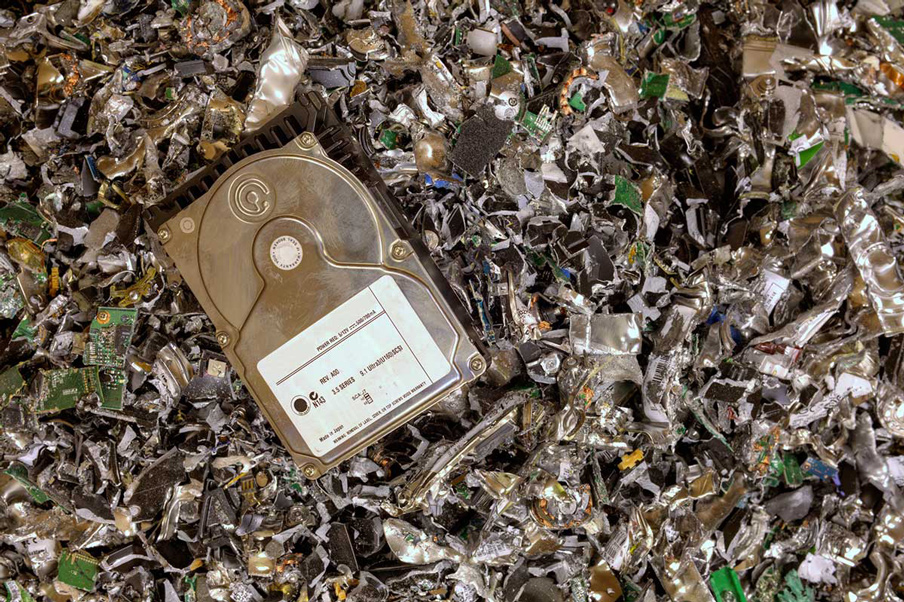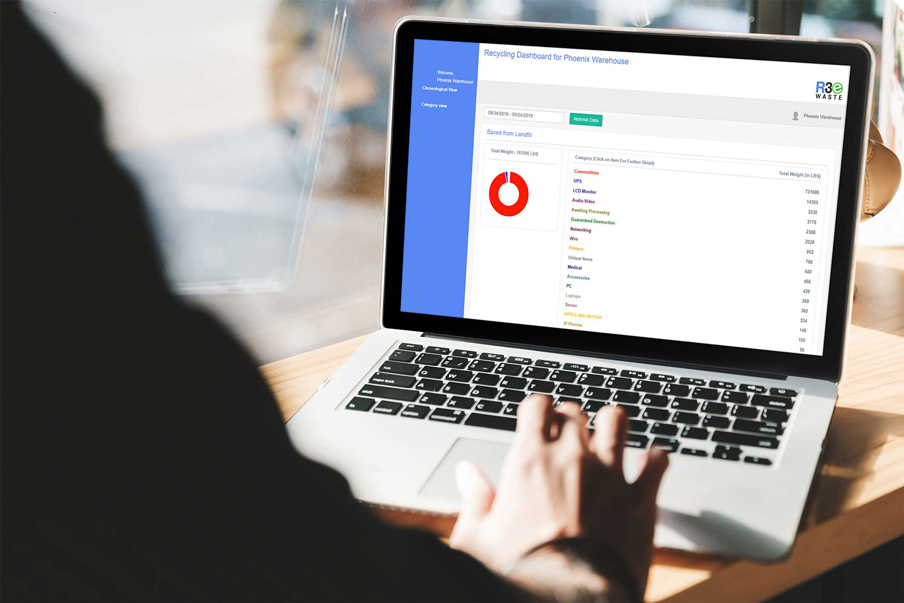ITAD Explained From a Recycler’s Perspective. Things You Need to Know.
ITAD is the abbreviation of Information Technology Asset Disposition. This is the overall process by which equipment (not necessarily exclusively electronics) is disposed of when no longer needed by the owner(s). The first fact that those outside the Ewaste Industry should know is that those within the EWaste sector do not consider asset disposition to be Electronics Recycling per se. ITAD is considered to be ‘Free Money’ as opposed to Electronics Recycling which is definitely not free money. This is why the competition for ITAD among Ewaste processors is so intense.
Google ITAD and invariably you will see website after website explaining how difficult and important every step in the process is and their commitment to the environment. Whilst I absolutely agree with the ‘Important’ part, the ‘difficult’ part, not so much. Electronics recycling is difficult. Reverse Logistics is difficult, IT asset disposition, relatively speaking, is not.
So, if you are responsible for ITAD within your organization, historically, the following statements summarize what you have been doing.
- You have been paying someone to send a truck to pick up wads of cash in steel cases.
- You are paying the labor costs to have someone pick up the wads of cash in steel cases.
- You then pay them to remove the steel and the rubber band from each wad of cash.
- You pay again for the peace of mind that the rubber bands will not be landfilled.
- You pay for the report containing all the serial numbers and the weight of steel and rubber.
- You are compensated for the cash, you might even get 50% or more back but that is before deducting all the costs mentioned above.
This is about as close to free money as you can get.
As the person responsible for asset disposition, the selection of your choice of equipment processor will typically depend on the following factors; usually with the following hierarchy of importance.
- Absolutely all of the data stored on any of the banknotes must be wiped clean.
- None of the banknotes, rubber bands or steel will end up in a landfill.
- Clear, consistent and precise reporting on the banknotes, steel and rubber bands.
- The reputation of the equipment processor.
- The confidence you have that your processor will maximize the value of your cash.
- The percentage of the cash returned to you.
- The costs charged against this percentage.
There actually should be other important considerations but usually these are not a factor. If you ask your current asset processor if they accept televisions, fax machines, old printers, VCR’s, video or sound equipment the answer is almost certainly a ‘no’. This may come across as cynical but it is easy to extol a commitment to the environment when all you accept are steel boxes stuffed with cash. A zero landfill, R2 Certified Ewaste recycler who accepts all electronics (even residential drop offs) demonstrates a far greater environmental commitment every day. An ITAD processing ‘specialist’ actually doesn’t do general Ewaste recycling because there isn’t as much money in it, why would they? So don’t believe the commitments to the environment; they want your good stuff that will be remarketed, not the general Ewaste with little value.

As a user of asset disposition services there are a number of considerations you may not be aware of that absolutely impact both sets of 1-7 above.
1. Tech-Cut
This is the point at which something is either remarketed or sold as scrap. The scrap value is obviously far lower than the remarketed value. Each ITAD or Ewaste processor has their own ‘Tech-Cut’. The lower value the Tech-Cut the more ‘stuff’ is processed as opposed to scrapped. Now, if the choice is between putting resources into 500 high end Cisco switches worth, say $2000 each or 500 computers worth $100 each which gets the resources? The switches, obviously. So what happens to the $50K of computers potentially processed? They are sold either as scrap ($0.26/Lb) or as untested ($20.00 each). At R3Ewaste our Tech-Cut is $2.00 which means that if something is worth more than $2.00 we will process it (this is a single stick of PC3 2GB memory). The eventual return on your assets is directly connected to the Tech-Cut. It is easy to promise a 50%+ return on remarketed assets if you are only processing $2000 switches. A far lower % share would result in far greater actual revenue if everything were processed. As a rule, the larger the processor the higher the Tech-Cut.
2. Broker vs. End User Value
Generally speaking end users are willing to pay more than a Broker for the same item – often 50% more. This is because the Broker is generally selling to end users and needs this margin to return a profit. Generally, because the turnover is quicker and easier ITAD ‘specialists’ sell to Brokers. So, that $2000 switch is now a $1300 switch. At R3Ewaste we always remarket to primarily end users.
3. Gleaming White Elephant Warehouses
These are expensive and someone has to pay for them and that someone is you. The transportation cost of shipping everything to one of a few processing centers is huge, all of which comes out of your return revenue too. At no charge, R3Ewaste will set up a dedicated, secure processing center close to your head office or data center and be operational within 60 days. We will take all of your recyclables (think empty toner, fax machines, etc) not just the high value electronics and provide you with comprehensive reports across the entire spectrum of your recycling from a single source. No, you don’t have to juggle 10 different downstream processors with 10 different reporting platforms.
4. Peace of Mind
I understand that peace of mind that your data is sanitized is more important than financial considerations. However, it is vastly over complicated by many service providers to justify exorbitant costs. I have been doing this for 20 years and have not had a single data breach. My customers include Medical Providers, Police Departments, Courts, Federal Government Departments, Counties and Cities. It really is not that difficult. Background checked, liveried staff in liveried secure trucks pack up and load the equipment, verified by your representatives. This gets taken to a secure and often dedicated facility. It is weighed and put in the ‘unprocessed’ section. Trained staff then go through everything to remove all data bearing devices. Another totally separate team goes through everything a second time. All drives then go to a secure ‘datawipe’ section marked for erasure. After erasure they are tested that they are indeed wiped. The Serial # on each drive is read by the software which then goes into our system. This is not complicated!!! You don’t need to be paying upwards of $10 per drive. Think about it; for example, 1000 drives per day per month = 23,000 drives @ $10 per drive = $230K. That would pay the rent on a 20K sq ft warehouse for nearly 2 years – in 1 month! Free money indeed and you don’t need to be paying this.

5. All Data on Any Device
The various service provider websites often suggest a series of questions you should be asking of your asset disposition candidates. One site I recently noticed suggested you really go into the minutiae of data destruction and evaluate what ‘sort’ of data you need sanitized. No mystery there, the short answer is ‘all data on any device’. This is an example of a provider attempting to overcomplicate what is essentially an absolutely routine but essential process. So whilst you should absolutely check Certifications, R2, NAID, RIOS, ISO, E-Stewards etc and most definitely ask to talk to existing customers I have put together a list of other, possibly awkward questions which will actually help in your evaluation process. Do not allow yourself to be led down a primrose path.
6. Genuine References
You should first ask to speak with some existing customers. Naturally, you will receive a short list of 3-5 customers who are a known ‘good’ reference. Then ask for the contact details of 2 customers who they have recently lost who are an equivalent volume producer as your organization. If they are prepared to provide ‘good’ references then attempt to hide behind confidentiality concerns beyond that, or even worse try to tell you that they have never lost a customer, think twice before jumping. If they do provide that information that is a good sign but call them anyway. Remember, any names you do get are going to be their ‘best’ lost customers.
7. Proof of Tech-Cut
Ask what their Tech-Cut is both in technology terms (i5 series 3rd gen processors on up) and in monetary terms as in ‘we don’t attempt to refurbish something that won’t sell for at least $100.’ It is important to know these answers before you describe the profile of the equipment you need to get processed. If your material profile straddles their tech-cut line it is not a good fit as half your material will be scrapped. If their tech-cut is below the profile of your material ask to see proof of sales of items at the bottom of their range. So, if they say $2.00 ask to see proof of those sales. Be aware, many recyclers claim their tech-cut to be lower during the sales process.
8. Sophisticated Software Platform
Many providers are not very sophisticated in the software arena and this can be a major problem in the future if your organization is at a higher level. Ask about their software platform, is it in-house developed or a commercially available product? Can it integrate with your own systems or can you get custom reports written? The important thing here is to make sure that your provider is your equal from a systems perspective. If you need a change to a standard report how easy will that be? If you are used to xml or web based delivery and they are still sending Excel Worksheets it’s probably not a good fit. Ask to see a variety of their standard reports. Brightly colored snazzy reports without much real data look nice but make sure you’re not buying the sizzle rather than the steak.

9. Dumpster Contents
This may seem a little odd but whilst touring their facility, have a look in their dumpster. Dumpster contents can be quite revealing.
10. Summary of Revenue Share
On revenue sharing, ask to see a summary of a revenue share report for an equivalent product profile producer as yourself. Then request one from a customer with a similar product profile but smaller volumes. They can blank out any identifying information but what you are looking for is the ratio of revenue to you after all deductions. If the ratio is similar be careful. Check carefully that you are indeed comparing apples to apples. It does not cost 3 times as much to process 3 times the volume; if your volumes are higher ask for a greater percentage. If your product profile is of higher specification than the other report it costs less per $ to process so ask for more.
11. Secure a Percentage of Scrapped Items
Ask how much you will be paid for the sales of the commodities generated from items that didn’t make the Tech-Cut. Most processors don’t even track these by customer. The upshot of this is that not only do you lose revenue because items are scrapped rather than remarketed, you won’t even get a percentage of revenue from the scrapped items. NOTE: The scrap value of 40K Lbs of circuit boards is easily $100K – typically you won’t get any of that; make sure you do.
12. Proprietary Processing Software
At all R3Ewaste facilities we have a weight scale beneath every commodity gaylord box that is linked to our proprietary software. When processing for customer ‘x’ we just tell our proprietary system who we are processing for and then if 10 lbs of wire gets tossed into the wire gaylord that will be registered to customer ‘x’. This is reported in real-time to the RecycleSoft reporting Dashboard (globally) and the R3Ewaste dashboard (Nationally) so you can now see the entire spectrum of your recycling program, down to the Lb (or Kg) through a browser based, drill anywhere reporting application. A downloadable app allows 3rd party downstream recyclers to report any other recycling activity to RecycleSoft which is then instantly shown on your recycling dashboard. You want to burnish your local green credentials? Just put a link to your R3Ewaste or RecycleSoft dashboard on your website, it will show your customers your commitment to recycling down to the pound, across all commodities and resold items.
13. 99% of Everything in Ewaste Has Value
I could go on at length with at least another 10 suggestions. Contact us at R3Ewaste and I’d be happy to oblige. I will leave you with this last suggestion; do not let anyone value your ‘stuff’. If you are sending out 9th generation and newer servers or 4th generation and newer i5 and i7 desktops you truly are sending out wads of cash in steel cases. Remember 99% of EVERYTHING in Ewaste has a value even if it is scrap value. Do your research into value on the open market then ask directly, ‘what is this worth?’ If you get a lot of humming and harring or well… it depends on this or that or we can’t know until we see it you ARE going to lose potentially a lot of money.

Perhaps the best approach would be to recognize that you are at risk of being the goose that lays the golden eggs, not egg singular. Make no mistake, there are a lot of very hungry foxes out there and you are the laying goose. Also it’s not easy to switch horses mid race once you have selected a horse, so carefully choose the right horse to begin with. You can be the gift that keeps on giving or you can forge a genuine partnership where you are properly compensated and your data security considerations (among others) are met.
A genuine partnership cuts both ways. Be warned, the Ewaste recycling industry has a very effective computerized grapevine. Do your research and raise a red flag if you feel it necessary but never, ever, circumvent your recycler especially if they are providing data on who they are selling to, when, what product and for how much it was sold for because they are being transparent. This is what you should want, not take advantage of.
